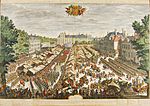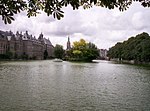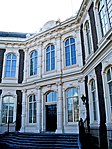Prince William V Gallery
Art museums established in 1774History of The HagueMuseums in The HagueRijksmonuments in The Hague

The Prince William V Gallery is an art gallery on the Buitenhof in The Hague that currently shares an entrance with the Gevangenpoort museum. It is a recreation of the original gallery Galerij Prins Willem V, once founded there by William V, Prince of Orange in 1774. The displayed paintings are part of the collection of the Mauritshuis. Amongst the paintings on display are works by Peter Paul Rubens, Jan Steen, Paulus Potter and Gerard van Honthorst.
Excerpt from the Wikipedia article Prince William V Gallery (License: CC BY-SA 3.0, Authors, Images).Prince William V Gallery
Buitenhof, The Hague Centrum
Geographical coordinates (GPS) Address Nearby Places Show on map
Geographical coordinates (GPS)
| Latitude | Longitude |
|---|---|
| N 52.079416666667 ° | E 4.3103861111111 ° |
Address
Buitenhof 34
2513 AH The Hague, Centrum
South Holland, Netherlands
Open on Google Maps










